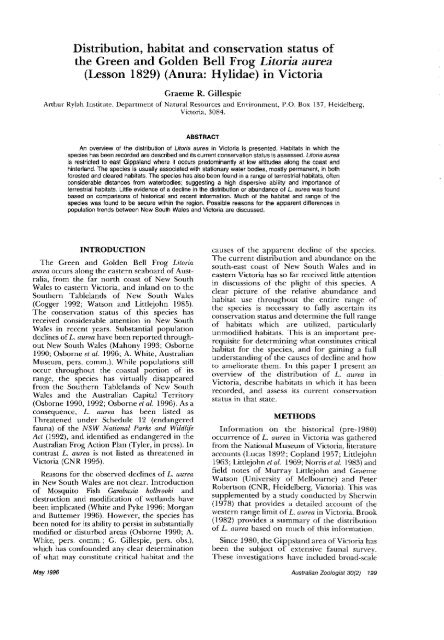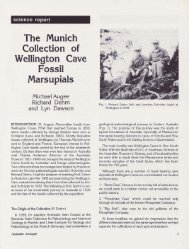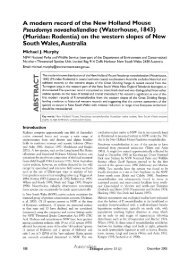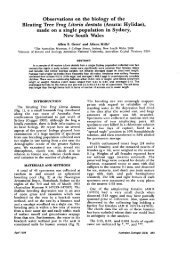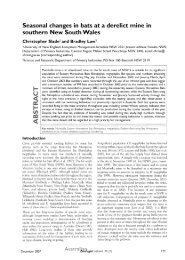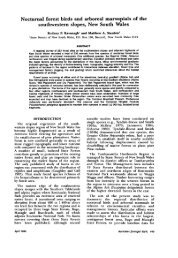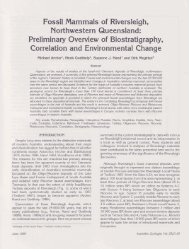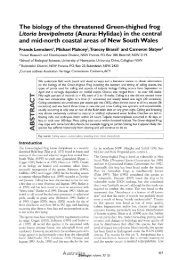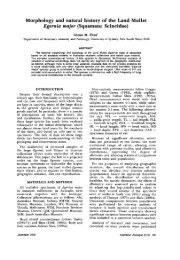Gillespie G R Distribution, habitat and conservation ... - RZS of NSW
Gillespie G R Distribution, habitat and conservation ... - RZS of NSW
Gillespie G R Distribution, habitat and conservation ... - RZS of NSW
Create successful ePaper yourself
Turn your PDF publications into a flip-book with our unique Google optimized e-Paper software.
~ ~<br />
~~,~<br />
~~~<br />
,<br />
~ ~<br />
~ ~<br />
~ ~ ,<br />
~ ~~~ ~-.<br />
~ .<br />
<strong>Distribution</strong>, <strong>habitat</strong> <strong>and</strong> <strong>conservation</strong> status <strong>of</strong><br />
the Green <strong>and</strong> Golden Bell Frog Litoria aurea<br />
(Lesson 1829) (Anura: Hylidae) in Victoria<br />
Graeme R. <strong>Gillespie</strong><br />
Arthur Rylah Institute, Dep;trtmrnt <strong>of</strong> Natural Resoul-ces <strong>and</strong> Environment, L'.O. Box 137, Heidelberg,<br />
Victoria, 3084.<br />
ABSTRACT<br />
An overview <strong>of</strong> the distribution <strong>of</strong> Litorfa aurea in Victoria is presented. Habitats in which the<br />
species has been recorded are described <strong>and</strong> its current <strong>conservation</strong> status is assessed. Liforia aurea<br />
is restricted to east GiDDsl<strong>and</strong> where it occurs Dredominantlv at low altitudes alona the coast <strong>and</strong><br />
hinterl<strong>and</strong>. The soecies'k ussallv associated with stationarv water bodies. mostiv 0e;manent. in both<br />
~~<br />
~~~~ ~ -- , .~~ ~ ~~<br />
foreslea an0 c eared nabtats The spec es nas also been lound n a range <strong>of</strong> lerreslr al naollals oltcn<br />
conslaerabe dstances from rraleroooles sLggestlng a high olspers vc aul ly ana mponance <strong>of</strong><br />
lerrestr a haotam. - de evidence <strong>of</strong> a oecine n the 0 strlb.l~on or abundance <strong>of</strong> L. aurea was foJno<br />
based on comparisons <strong>of</strong> historical <strong>and</strong> recent information, Much <strong>of</strong> the <strong>habitat</strong> <strong>and</strong> range <strong>of</strong> the<br />
species was found to be secure within the region. Possible reasons for the apparent diflerences in<br />
population trends between New South Wales <strong>and</strong> Victoria are discussed.<br />
INTRODUCTION<br />
The Green <strong>and</strong> Golden Bell Frog Liloriu<br />
aureu occurs along the eastern seaboard <strong>of</strong> Australia,<br />
from the far north coast <strong>of</strong> New South<br />
Wales to eastern Victoria, <strong>and</strong> inl<strong>and</strong> on to the<br />
Southern Tablel<strong>and</strong>s <strong>of</strong> New South Wales<br />
(Cogger 1992; Watson <strong>and</strong> Littlejohn 1985).<br />
The <strong>conservation</strong> status <strong>of</strong> this species has<br />
received considerable attention in New South<br />
Wales in recent years. Substantial population<br />
declines <strong>of</strong> L. aurea have been reported throughout<br />
New South Wales (Mahony 1993; Osborne<br />
1990; Osborne et al. 1996; A. White, Australian<br />
Museum, pers. comm.). While populations still<br />
occur throughout the coastal portion <strong>of</strong> its<br />
range, the species has virtually disappeared<br />
from the Southern Tablel<strong>and</strong>s <strong>of</strong> New South<br />
Wales <strong>and</strong> the Australian Capital Territory<br />
(Oshorne 1990, 1992; Osborne el al. 1996). As a<br />
consequence, L. aurea has been listed as<br />
Threatened under Schedule 12 (endangered<br />
fauna) <strong>of</strong> the <strong>NSW</strong> Nalional Park <strong>and</strong> Wildlife<br />
Act (1992), <strong>and</strong> identified as endangered in the<br />
Australian Frog Action Plan (Tyler, in press). In<br />
contrast L. aurea is not listed as threatened in<br />
Victoria (CNR 1995).<br />
Reasons for the observed declines <strong>of</strong> L, aurea<br />
in NervSouth Wales are not clear. Introduction<br />
<strong>of</strong> Mosquito Fish Gambtisiu. holbrooki <strong>and</strong><br />
destruction <strong>and</strong> modification <strong>of</strong> wetl<strong>and</strong>s have<br />
been implicated (White <strong>and</strong> Pyke 1996; Morgan<br />
<strong>and</strong> Buttemer 1996). However, the species has<br />
been noted tor its ability to persist in substantially<br />
modified or disturbed areas (Osborne 1990: A.<br />
White, pers, comm.; G. ~iliespie, pers. obs.),<br />
which has confounded any clear determination<br />
<strong>of</strong> what may constitute critical <strong>habitat</strong> <strong>and</strong> the<br />
causes <strong>of</strong> the apparent decline <strong>of</strong> the species.<br />
The current distribution <strong>and</strong> abundance on the<br />
south-east coast <strong>of</strong> New South Wales <strong>and</strong> in<br />
eastern Victoria has so far received little attention<br />
in discussions <strong>of</strong> the plight <strong>of</strong> this species. A<br />
clear picture <strong>of</strong> the relative abundance <strong>and</strong><br />
<strong>habitat</strong> use throughout the entire range <strong>of</strong><br />
the species is necessary to fully ascertain its<br />
<strong>conservation</strong> status <strong>and</strong> determine the 11111 range<br />
<strong>of</strong> <strong>habitat</strong>s which are utilized, particularly<br />
unmodified <strong>habitat</strong>s. This is an important prerequisite<br />
for determining what constitutes critical<br />
<strong>habitat</strong> for the species, <strong>and</strong> for gaining a full<br />
underst<strong>and</strong>ing <strong>of</strong> the causes <strong>of</strong> decline <strong>and</strong> how<br />
to ameliorate thetn. In this paper I present an<br />
overview <strong>of</strong> the distribution <strong>of</strong> L. aurea in<br />
Victoria, describe <strong>habitat</strong>s in which it has been<br />
recorded, <strong>and</strong> assess its current <strong>conservation</strong><br />
status in that state.<br />
METHODS<br />
Information on the historical (PI-e-1980)<br />
occurrence <strong>of</strong> L. u.urea in Victoria was gathered<br />
lrom the National Museum <strong>of</strong> Vicloria, literatul-e<br />
accounts (Lucas 1892; Copl<strong>and</strong> 1957; Littlejohn<br />
1963; Littlejohn el al. 1969; Norris et al. 1983) <strong>and</strong><br />
field notes <strong>of</strong> Murray Littlejohn <strong>and</strong> Graeme<br />
Watson (University <strong>of</strong> Melbourne) <strong>and</strong> Peter<br />
Robertson (CNR, Heidelberg, Victol-La). This was<br />
supplemented by a study conducted by Sher\vin<br />
(1978) that provides a detailed account ol the<br />
western range limit <strong>of</strong> L. uurea in Victoz-id. Brook<br />
(1982) provides a summary <strong>of</strong> the distribution<br />
<strong>of</strong> L, nzlrpa based on much <strong>of</strong> this information.<br />
Since 1980, the Gippsl<strong>and</strong> area <strong>of</strong> Victoria has<br />
been the subject <strong>of</strong> extensive faunal survey.<br />
These investigations have included broad-scale<br />
May 1996 Australfan Zoologisf 30(2) 199
egional survey (Norris et ul. 1983; LCC 1985;<br />
Victorian Wildlife Atlas) <strong>and</strong> numerous forest<br />
management block surveys (Chesterfield et al.<br />
1983; Carrel al. 1984; Horrocks et al. 1984; Opie<br />
et al. 1984; Brown el al. 1986; Cherry et al. 1986;<br />
Brown el al. 1987; Horrocks et al. 1987; Madarlane<br />
et ul. 1987; Yugovic et al. 1987; Chesterfield et<br />
al. 1988; Henry el al. 1988; Earl et al. 1989; Opie<br />
et al. 1990; Westaway el al. 1990a,b; Lobert et al.<br />
1991; Loyn et al. 1992; Peacock el al. 1992;<br />
<strong>Gillespie</strong> et al. 1992). Nine other unpublished<br />
surveys have been conducted in East Gippsl<strong>and</strong> by<br />
CNR <strong>and</strong> the data are included in the Victorian<br />
Wildlife Atlas. These surveys have provided<br />
much <strong>of</strong> the available knowledge on distribution<br />
<strong>and</strong> <strong>habitat</strong> occurrence <strong>of</strong> L. aurea since 1980.<br />
These data have also been supplemented by the<br />
author's incidental observations <strong>and</strong> those <strong>of</strong><br />
other biologists (Jeanette Kemp, Townsville,<br />
Queensl<strong>and</strong>, pers. comm.; Harry Hines, <strong>NSW</strong><br />
National Parks <strong>and</strong> WildliFe Service, Armidale,<br />
pers. comm.; Barbara Triggs, Dead Finish,<br />
Victoria, pers. comm.).<br />
Trends <strong>of</strong> populations <strong>of</strong> L. aurea in Victoria<br />
were examined firstly by comparing the range <strong>of</strong><br />
the species as is currently known (based on post-<br />
1990 records) with the historical known range<br />
(pre-1980 records). No rigorous quantitative<br />
data have been collected on the relative<br />
abundance <strong>of</strong> L. aurea over time at any sites.<br />
Survey effort throughout the range <strong>of</strong> the<br />
species is also inconsistent over time. Therefore,<br />
no rigorous assessment <strong>of</strong> changes in population<br />
size or local patterns <strong>of</strong> distribution are possible,<br />
except where the species has disappeared from<br />
known localities. To assess any broad changes in<br />
relative abundance over time, the relative<br />
proportions <strong>of</strong> records <strong>of</strong> different numbers <strong>of</strong><br />
frogs detected were compared across different<br />
time periods. A chi-squared test was used to<br />
assess differences in the relative proportions <strong>of</strong><br />
records <strong>of</strong> individual frogs, 2-10, 11-100 <strong>and</strong><br />
over 100 individuals across three time periods,<br />
pre-1980, 1980-1989 <strong>and</strong> 1990-present. The<br />
rationale <strong>of</strong> this approach is that over a broad<br />
period <strong>of</strong> time the detection rates <strong>of</strong> single <strong>and</strong><br />
multiple frogs should remain broadly similar,<br />
despite differences in sampling effort unless<br />
there is a substantial change in the overall<br />
abundance <strong>of</strong> the species.<br />
Fig. I. <strong>Distribution</strong> <strong>of</strong> 5 X 5 minute grids in which Liforia<br />
aurea has been recorded in Victoria. (Note: Each cell<br />
mav contain more than one record.) Source: Atlas <strong>of</strong><br />
~i;mzan Wildlife; Brook 1982; ~iown el 01. 1987;<br />
Earl el al. 1989.<br />
Lake Wellington, near Bairnsdale (Fig. 1).<br />
There is a contact zone with L. ranijormis<br />
!<br />
between the Lake Wellington area <strong>and</strong> the<br />
Brodribb River, in which intermediate forms<br />
have been recorded (Sherwin 1978). Within this<br />
i<br />
area positive identification <strong>of</strong> taxa is not always<br />
I<br />
possible. The disjunction in the distribution<br />
south-west <strong>of</strong> Mallacoota probably reflects a lack<br />
<strong>of</strong> field sampling, due to limited access into this<br />
area. !<br />
East Gippsl<strong>and</strong> comprises a diversity <strong>of</strong> l<strong>and</strong>forms<br />
tbat range through coastal dunes <strong>and</strong><br />
plains to dissected foothills, <strong>and</strong> a hinterl<strong>and</strong><br />
tbat rises to over 1 400 m, with a variety <strong>of</strong> intermontane<br />
basins <strong>and</strong> montane plateaux. Unlike<br />
the rest <strong>of</strong> Victoria, the climate is subjected to a<br />
strong easterly influence. Rainfall is spread<br />
evenly throughout the year <strong>and</strong> ranges from<br />
less than 700 mm in the rain shadow country<br />
<strong>of</strong> the upper Snowy River to 2 000 mm on<br />
the Errinundra Plateau in the centre <strong>of</strong> the<br />
regi0n. The average minfal' is in the<br />
90&1 000 mm (Woodgate et al. 1993). The<br />
"%ion remains predominantly forested, with<br />
The current <strong>conservation</strong> status <strong>of</strong> L. aurea in<br />
IJictoria was assessed by examining potential<br />
threats to known <strong>habitat</strong> within the range <strong>of</strong> the<br />
species. ~ ~ ~ <strong>of</strong> the ~ species ~ in the ~ clearing ~ for ~ agriculture t being ~ restricted t i largely ~ ~<br />
current reserve system was also evaluated. to coastal plains in the Gippsl<strong>and</strong> Lakes area.<br />
Other areas <strong>of</strong> clearance are restricted to<br />
RESULTS AND DISCUSSION<br />
terraces <strong>of</strong> the Snowy, Brodribb, Cann <strong>and</strong><br />
Genoa Rivers. <strong>and</strong> the southern mareins <strong>of</strong> the<br />
General <strong>Distribution</strong> Monaro ablel l<strong>and</strong>s <strong>and</strong> fringing hill:along the<br />
The distribution <strong>of</strong> L. aurea in Victoria is<br />
restricted to East Gippsl<strong>and</strong> <strong>and</strong> extends From<br />
the eastern border with New South Wales to<br />
New South Wales border.<br />
Litorin aurea is found predominantly on the<br />
coastal plains <strong>and</strong> low foothills <strong>of</strong> the hinterl<strong>and</strong><br />
200 Australian Zoologist 30(2) May 1996<br />
!
2 7<br />
7<br />
0<br />
" ? ? 10 LO 0 LO 0<br />
o o o 0 0 o o o o o 0 o a<br />
0 0 L O O Y) 0 0<br />
F<br />
.- '? P P Y Y '? '? '?<br />
7 7 7 7 7 .- 7 F 7 7<br />
In In 0 10 0<br />
z - N N<br />
; 10<br />
m 0 0 * * 0 "7 LO 010 LO (D<br />
Altitude intervals (m a.s.1.)<br />
Fzs. 2. Alritudinal datribution <strong>of</strong> records <strong>of</strong> Litot?~ aurm in Victoria.<br />
although populations also occur inl<strong>and</strong> along<br />
terraces <strong>of</strong> the Brodribb, Cann <strong>and</strong> Genoa<br />
Rivers. At the western extremity <strong>of</strong> its range it<br />
is restricted to the coastal fringe. Most records<br />
have been from near the coast below 50 m a.s.1.<br />
Records <strong>of</strong> L. aurea drop <strong>of</strong>f sharply above<br />
200 m a.s.1. (Fig. 2). The number <strong>of</strong> records <strong>of</strong><br />
I*. uureu also diminishes away from the coast<br />
which may reflect a progressive rise in altitude.<br />
With the exception <strong>of</strong> one record at 670 m near<br />
Yalmy Road, all other inl<strong>and</strong> records indicated<br />
in Figure 1 are along major river valleys.<br />
Brook (1982) documents a record <strong>of</strong> L. aurea<br />
from the southern Monaro Tablel<strong>and</strong>s near<br />
Bendoc. The precise locality is unknown but is<br />
at least 800 m a.s.1. However, the taxonomic<br />
identity ol this record is uncertain. The record<br />
originates from a field observation; no specimen<br />
was collected <strong>and</strong> no call recording was made.<br />
Litoriu aurea has not been recorded in this region<br />
<strong>of</strong> New South Wales (Osborne el al. 1995;<br />
Thompson et al. 1995). Litaria ranfonr~is has<br />
been collected from this area (Museum <strong>of</strong><br />
Victoria records) <strong>and</strong> call data collected by<br />
Murray I,ittlejohn, University <strong>of</strong> Melbourne<br />
(pers. comm.) suggests that LlroriaJluuiyunctnta<br />
(Courtice <strong>and</strong> Grigg 1975) may also have occurred<br />
there. The morphological similarities <strong>of</strong> this<br />
group may make field identification difficult it1<br />
the absence <strong>of</strong> call data, particularly given the<br />
potential for hybridization between taxa.<br />
Further doubt is cast on the existence <strong>of</strong>L. auren<br />
in this area by the disparity between the en\' '~ronment<br />
there <strong>and</strong> that <strong>of</strong> the general distribution<br />
<strong>of</strong> L. aurea in East Gippsl<strong>and</strong>. The species is<br />
restricted to warm temperate environments<br />
while the southern edge <strong>of</strong> the Monaro Tablel<strong>and</strong>s<br />
is cold temperate, comprising wet montane<br />
<strong>and</strong> sub-alpine environments.<br />
May 1996 Australian Zoologist 30(2) 201
Habitat<br />
Lito?ia aurea has been recorded in a range <strong>of</strong><br />
lentic <strong>and</strong> terrestrial <strong>habitat</strong>s in Victoria. Breedlng<br />
activity, by way <strong>of</strong> calling or presence <strong>of</strong><br />
larvae, has been documented from dams in both<br />
forested <strong>and</strong> cleared areas, swamps in farml<strong>and</strong>,<br />
gravel pits (Brown el al. 1987), billabongs (G.<br />
<strong>Gillespie</strong>, pers. obs.), marshes, coastal lagoon<br />
wetl<strong>and</strong>s (H. Hines, pers. obs.; G. <strong>Gillespie</strong>,<br />
pers. obs.), wet swale herbl<strong>and</strong>s u. Kemp, pers.<br />
comm.; G. <strong>Gillespie</strong>, pers. obs.), isolated streamside<br />
pools (G. <strong>Gillespie</strong>, pers. obs.). These<br />
<strong>habitat</strong>s are mostly permanent but include some<br />
ephemeral water bodies. Males have also been<br />
heard calling from amongst dense riparian<br />
scrub along still sections <strong>of</strong> streams (<strong>Gillespie</strong>,<br />
pers. obs.; P. Robertson, pers. comm.). All<br />
<strong>habitat</strong>s are characterized by stationary water.<br />
Virtually all are isolated water bodies, free <strong>of</strong><br />
native fish species. All sites observed by the<br />
author typically have dense emergent vegetation.<br />
At sites in pastoral areas this vegetation<br />
usually comprises Juncus spp. <strong>and</strong> other sedges,<br />
while in naturally vegetated areas Melaleuca<br />
squarrosa <strong>and</strong> Gahnia spp. dominate.<br />
In Victoria Litoria aurea has been heard calling<br />
from mid-September to early January (Atlas <strong>of</strong><br />
Victorian Wildlife; G. <strong>Gillespie</strong>, pers. obs.; B.<br />
Triggs, pers. comm.). Calling activity appears to<br />
be most intense on warm nights from late<br />
October to late December. Tadpoles (Gosner<br />
stage - late 30s) have been observed between<br />
February <strong>and</strong> April (G. <strong>Gillespie</strong>, pers. obs.).<br />
In lowl<strong>and</strong> areas <strong>of</strong> East Gippsl<strong>and</strong>, permanent<br />
swamps, billabongs <strong>and</strong> temporarily inundated<br />
heathl<strong>and</strong>s form an extensive mosaic <strong>of</strong> water<br />
bodies along the coastal plain. Much <strong>of</strong> these<br />
wetl<strong>and</strong> <strong>habitat</strong>s remain largely intact. The<br />
availability <strong>of</strong> these <strong>habitat</strong>s diminishes inl<strong>and</strong><br />
due to the increased topographic relief. This<br />
change may be a major factor, apart from climatic<br />
differences, in largely excluding L. aurea from<br />
the more dissected hinterl<strong>and</strong>, except along<br />
major water courses where billabongs <strong>and</strong><br />
swamps occur. These areas are also warmer <strong>and</strong><br />
have a lower rainfall.<br />
Litaria aurea has been found in a diversity <strong>of</strong><br />
terrestrial <strong>habitat</strong>s including Lowl<strong>and</strong> Forest<br />
(<strong>Gillespie</strong> el al. 1992), Banksia Woodl<strong>and</strong>, Wet<br />
Heathl<strong>and</strong>, Riparian Scrub Complex, Riparian<br />
Shrubl<strong>and</strong> (G. <strong>Gillespie</strong>, pers. obs.), Riparian<br />
Forest (Earl el al. 1989), Damp Forest, Shrubby<br />
Dry Forest (G. <strong>Gillespie</strong>, pers. obs), Limestone<br />
Box Woodl<strong>and</strong> (Atlas <strong>of</strong> Victorian Wildlife) <strong>and</strong><br />
cleared pastoral areas (Brown et al. 1987;<br />
G. <strong>Gillespie</strong>, pers. obs.). Woodgate el al. (1993)<br />
provide definitions <strong>and</strong> descriptions <strong>of</strong> these<br />
ecological vegetation classes.<br />
Riparian Scrub Complex, Riparian Shrubl<strong>and</strong><br />
<strong>and</strong> Riparian Forest usually occur along drainage<br />
gullies <strong>and</strong> riparian margins, Wet Heathl<strong>and</strong><br />
usually occupies the zone between Riparian<br />
Scrub <strong>and</strong> adjacent better-drained <strong>habitat</strong>s<br />
(Mioodgate et al. 1993). These <strong>habitat</strong>s are therefore<br />
<strong>of</strong>ten proximal to aquatic environments<br />
favoured by L. aurea. In contrast, Lowl<strong>and</strong><br />
Forest <strong>and</strong> Banksia Woodl<strong>and</strong> are widespread<br />
<strong>habitat</strong>s occurring in better-drained areas.<br />
Litoria aurea has been recorded frequently on<br />
forest tracks in these <strong>habitat</strong>s on wet nights;<br />
<strong>of</strong>ten over 1 km from any water bodies typically<br />
used by the species (G. <strong>Gillespie</strong>, pers. obs.).<br />
Isolated occurrences <strong>of</strong> L, aurea have been<br />
recorded on Shrubby Dry Forest ridges on wet<br />
nights <strong>and</strong> in Damp Forest several hundred<br />
metres from major drainage lines or other water<br />
bodies (G. <strong>Gillespie</strong>, pers. obs.). These observations<br />
indicate that L. aurea is relatively mobile<br />
<strong>and</strong> has the potential to forage <strong>and</strong> disperse over<br />
large areas away from aquatic environments.<br />
The importance <strong>of</strong> dispersal <strong>and</strong> terrestrial<br />
<strong>habitat</strong>s to maintenance <strong>of</strong> populations is<br />
unknown, but it suggests that assessments <strong>of</strong><br />
<strong>habitat</strong> requirements <strong>of</strong> L. aurea need to<br />
incorporate examination <strong>of</strong> a broader range <strong>of</strong><br />
criteria beyond just aquatic <strong>habitat</strong>s.<br />
Population Trends <strong>and</strong> Conservation Status<br />
Despite the relative intense survey history <strong>of</strong><br />
the Gippsl<strong>and</strong> area over the past 13 years, there<br />
is virtually no quantitative data on populations<br />
<strong>of</strong> L. aurea over any time period which would<br />
allow an assessment <strong>of</strong> population trends. These<br />
Faunal surveys, as with most other general<br />
surveys co~iducted in Australia, deal poorly with<br />
amphibians. Frogs generally have episdic activity<br />
patterns, patchy distributions across the l<strong>and</strong>scape,<br />
<strong>and</strong> are otherwise cryptic by nature.<br />
Hylids generally cannot be trapped, so active<br />
searching techniques are required to quantify<br />
numbers. Intensive <strong>and</strong> repeated surveys are<br />
therefore required to gain any realistic assessment<br />
<strong>of</strong> relative abundance <strong>and</strong> distribution.<br />
Surveys conducted in East Gippsl<strong>and</strong> were <strong>of</strong>ten<br />
ol' short duration (2-4 weeks) <strong>and</strong> were conducted<br />
in different areas in different seasons <strong>and</strong> years.<br />
The data on amphibians from these surveys, for<br />
the most part, provide only once-<strong>of</strong>f, presenceonly<br />
information. In view <strong>of</strong> this, it is not<br />
possible to assess any changes in the status <strong>of</strong><br />
populations <strong>of</strong> L. aurea in Victoria with any<br />
rigour. However, several broad trends can be<br />
discerned from the extensive survey <strong>and</strong><br />
incidental data collected in the region.<br />
Comparisons <strong>of</strong> the known occurrence <strong>of</strong> L.<br />
aurea in Victoria between different time periods<br />
suggests that there has been no discernible<br />
change in the range <strong>of</strong> the species from historical<br />
(pre-1980) times to that detected during the past<br />
five years (Fig. 3). The relative paucity <strong>of</strong><br />
records during the 1980's probably reflects the<br />
low survey effort in the core range <strong>of</strong> L. aurea.<br />
202 Australian Zoologisl30(2)
<strong>of</strong> largel- aggrerations, with only one report <strong>of</strong><br />
over 100 individuals. This was an estimate <strong>of</strong><br />
several hundred males calling from swamp l<strong>and</strong><br />
near Sydenham Inlet (H. Hines, pers. comm.).<br />
Large aggregations (< 100 individuals) have also<br />
been observed on the Snowy River flood plains<br />
<strong>and</strong> Wet Swale Herbl<strong>and</strong>s along the coast in<br />
Ewings Marsh Flora Reserve (G. <strong>Gillespie</strong>, pers.<br />
obs.). There are also Sew I-eports <strong>of</strong> large aggregations<br />
<strong>of</strong> L. aurea (>I0 individuals) Srom prior<br />
to 1980 (M. Littlejohn, pen. comm; G. Watson,<br />
pers. comm.; Sherwin 1978). Comparison <strong>of</strong> the<br />
relative proportions ol' numbers <strong>of</strong> frogs<br />
detected per record (Fig. 4) show no significant<br />
difference across time periods (x' = 4.359,<br />
d.l: = 6, P > 0.05). This does not account<br />
for differing sampling intensities, sampling<br />
technique or surveyor differences. Data on<br />
numbers <strong>of</strong> frogs present at PI-eel980 sites are<br />
likely to be conservative because they are based<br />
largely on museum records <strong>of</strong> numbers collected<br />
rather than those observed. These factors may<br />
weaken the comparison somewhat, nevertheless<br />
the high similarity between time periods does<br />
suggest that the relative abundance <strong>of</strong> L. aurea<br />
has not changed substantially during the past 20<br />
years. These data also suggest that, in contrast<br />
to the historic situation in New South Wales<br />
(A. White, pers. comm.), large aggregations <strong>of</strong><br />
L. aurea are atypical in Victoria.<br />
Fig 3. Dirrribution <strong>of</strong> 5 X 5 minute grid records <strong>of</strong>titwizaurea<br />
in Victoria during different time periods: (a) prior to<br />
1980, (b) 1980-1989, <strong>and</strong> (c) 1990 ro present.<br />
In contrast, surveys since 1990 were conducted<br />
in coastal <strong>and</strong> lowl<strong>and</strong> areas.<br />
Figure 4 shows that L. aurea was detected<br />
much more frequently during the past five<br />
years, with over 70 records. This increase in<br />
sightings may be largely an artefact <strong>of</strong> the high<br />
survey effort across lowl<strong>and</strong> parts <strong>of</strong> the region;<br />
however, several other species known from the<br />
region were detected much less frequently (e.g.,<br />
Giant Burrowing Frog Heleiopom awlraliacw,<br />
Large Brown Tree Frog Liton'a littlejohni <strong>and</strong><br />
Martins Toadlet Uperoleia martini) or not at all<br />
(e.g., Southern Barred Frog Mixophyes balbw)<br />
(Atlas <strong>of</strong> Victorian Wildlife).<br />
Estimates <strong>of</strong> the number <strong>of</strong> frogs present at a<br />
site vary widely. Mostly single individuals have<br />
been detected but records <strong>of</strong> up to 10 individuals<br />
are not uncommon. There are very few records<br />
Two reports <strong>of</strong> local disappearances <strong>of</strong> L.<br />
aureu have been received from East Gippsl<strong>and</strong>.<br />
A Litoria aurea complex population known from<br />
East Lakes Entrance was last observed in the late<br />
1960s (B. Peel, Flora <strong>and</strong> Fauna Branch, CNR,<br />
pers. comm.). This locality has been completely<br />
modified by urban de\,elopment. A population<br />
<strong>of</strong> L, aurea disappeared from a swamp north <strong>of</strong><br />
Mallacoota after the 1982183 drought, during<br />
which the swamp dried up. However, the species<br />
recently recolonized the swamp (B. Triggs, Dead<br />
Finish, hlallacoota, Victoria, pers. comm.). This<br />
is consistent with observations <strong>of</strong> several other<br />
species suffering severe population reductions<br />
in Victoria at this time, such as the Southern<br />
Brown Tree Frog Litoria ewingzi (M. Littlejohn,<br />
University <strong>of</strong> Melbourne, pers. comm.) <strong>and</strong><br />
Growling Grass Frog L. raniformis (P. Robertson,<br />
Flora <strong>and</strong> Fauna Branch, CNR, Heidelberg,<br />
pers. comm.).<br />
Potentially threatening processes for L. aurea<br />
in East Gippsl<strong>and</strong> are relatively Sew compared<br />
with many areas in New South Wales, largely<br />
due to the very low human population in the<br />
area. Most <strong>of</strong> the region remains naturally<br />
vegetated. Pastoral areas comprise I-elatively<br />
small patches within a forest l<strong>and</strong>scape, rather<br />
than the reverse. Therefore impacts from agricultural<br />
run <strong>of</strong>f <strong>and</strong> human settlement are<br />
minimal. Although timber harvesting occurs<br />
extensively in the region, this practice may not
I<br />
Total records<br />
fl singte individual record<br />
% z-lo individuals per record<br />
Q<br />
50<br />
o<br />
u<br />
E<br />
b40<br />
o<br />
El t t -t oo individuals per record<br />
ffin Over 100 individuals per recod<br />
z<br />
2n<br />
pre 1980 1 980-89<br />
Time lnterval<br />
1990 - present<br />
Fig. 4. Total numbers <strong>of</strong> records <strong>of</strong> Litoria aurea <strong>and</strong> proportions <strong>of</strong> abundance classes during different time periods.<br />
significantly adversely affect l,. aurea, due to rts<br />
ability to persist in significantly modified<br />
<strong>habitat</strong>s, <strong>and</strong> its mobility <strong>and</strong> potential to<br />
recolonize. In addition, a large portion <strong>of</strong><br />
the range <strong>of</strong> the species is within either the<br />
Croajingalong National Park or other coastal<br />
reserves. In the absence <strong>of</strong> any evidence <strong>of</strong><br />
decline, the species is therefore considered<br />
secure in Victoria (CNR 1995).<br />
CONCLUSIONS<br />
The population trends <strong>of</strong> L. aurea in New<br />
South Wales are not reflected in East Gippsl<strong>and</strong>.<br />
There is no compelling evidence <strong>of</strong> a substantial<br />
decline <strong>and</strong> the species appears to occur in<br />
relatively low numbers compared with historical<br />
accounts from the east coast, There are several<br />
differences between East Gippsl<strong>and</strong> <strong>and</strong> the east<br />
coast <strong>of</strong> New South Wales which may explain<br />
these differences. Most <strong>of</strong> East Gippsl<strong>and</strong><br />
remains largely undisturbed with a low human<br />
population. The mosaic <strong>of</strong> wetl<strong>and</strong>s throughout<br />
204 Australian Zoologist 30(2)<br />
the lowl<strong>and</strong>s <strong>and</strong> coastal fringes remain relatively<br />
intact except at the western limit <strong>of</strong> distribution<br />
<strong>of</strong> the species. In contrast the natural vegetation<br />
<strong>of</strong> many areas <strong>of</strong> the east coast is much more<br />
fragmented, <strong>and</strong> water bodies suitable for<br />
breeding are reduced in number <strong>and</strong> quality.<br />
These two factors may significantly increase the<br />
distance between suitable breeding <strong>and</strong> refuge<br />
<strong>habitat</strong>s <strong>and</strong> thus reduce the dispersal <strong>and</strong><br />
colonization ability <strong>of</strong> the species. This would be<br />
further exacerbated by the urbanization <strong>and</strong><br />
road infrastructure. Small, isolated populations<br />
would then be more vulnerable to local extinction<br />
due to environmental stochastic events, such as<br />
drought, <strong>and</strong> would be less likely to be<br />
recolonized. Larger populations would be<br />
similarly vulnerable if these events are severe<br />
enough or if the breeding <strong>habitat</strong>s are unstable.<br />
Under this model, the populations that are most<br />
likely to survive are those that were largest in<br />
the first place <strong>and</strong> that have the most reliable<br />
breeding <strong>habitat</strong> through time.<br />
May 1996
Plate 3a (top left). Lztorza aurea, Genoa Peak Road, East<br />
Gippsl<strong>and</strong>, Victoria. Note the plain green dorsal<br />
colour. Photo: G. <strong>Gillespie</strong>.<br />
Plate 3b (top right). Lztoria aurea, Bonang Highway, East<br />
Gippsl<strong>and</strong>, Victoria. Note the green <strong>and</strong> brown dorsal<br />
pattern. Photo: G. <strong>Gillespie</strong>.<br />
Plate 3c (bottom left). Lztona aurea breeding <strong>habitat</strong>, Cabbage<br />
Tree Lagoon, East Gippsl<strong>and</strong>, Victoria.<br />
The relatively intact l<strong>and</strong>scape <strong>of</strong> East Gippsl<strong>and</strong><br />
may provide a greater continuity <strong>of</strong> <strong>habitat</strong><br />
with a higher density <strong>of</strong> breeding or refuge<br />
areas. The potential for dispersal <strong>and</strong> recolonization<br />
after unfavourable disturbances therefore<br />
remains high. In addition, apart from isolated<br />
occurrences in farm dams, the Mosquito Fish<br />
Gambusia holbrooki is absent from the region east<br />
<strong>of</strong> the Snowy River in Victoria. This spgcies has<br />
the potential to substantially increase mortality<br />
<strong>of</strong> L. aurea tadpoles (L. Morgan, Honours Thesis<br />
in prep.). Its absence may mean that a greater<br />
range <strong>of</strong> aquatic <strong>habitat</strong>s remain suitable for<br />
reproduction for L. aurea, more colonies can<br />
persist in a given area <strong>and</strong> the distribution is less<br />
patchy. Although L. aurea is known to persist in<br />
cleared or otherwise highly modified areas, the<br />
availability <strong>of</strong> natural vegetation my still increase<br />
dispersal <strong>and</strong> foraging ability <strong>and</strong> may also<br />
ameliorate the impacts <strong>of</strong> environmental stresses,<br />
such as droughts <strong>and</strong> fires, or predation, by<br />
providing refuge areas. In the environment <strong>of</strong><br />
East Gippsl<strong>and</strong>, local stability <strong>of</strong> breeding <strong>and</strong><br />
refuge <strong>habitat</strong> may be far less important to the<br />
persistence <strong>of</strong> the species compared with areas<br />
in New South Wales, due to the greater availability<br />
<strong>of</strong> <strong>habitat</strong> <strong>and</strong> the ability to disperse <strong>and</strong><br />
recolonize.<br />
East Gippsl<strong>and</strong> provides an opportunity to<br />
study factors influencing <strong>habitat</strong> use <strong>and</strong><br />
population dynamics <strong>of</strong> L. aurea in an area<br />
where populations <strong>of</strong> the species have persisted,<br />
rather than declined. An underst<strong>and</strong>ing <strong>of</strong> the<br />
roll <strong>of</strong> l<strong>and</strong>scape factors, such as natural vegetation<br />
patterns, spatial <strong>and</strong> temporal distribution<br />
<strong>of</strong> available aquatic <strong>habitat</strong>s <strong>and</strong> disturbance<br />
regimes, is likely to be important in determining<br />
processes limiting the distribution <strong>and</strong> abundance<br />
<strong>of</strong> the species. Examination <strong>of</strong> local <strong>habitat</strong> <strong>and</strong><br />
l<strong>and</strong>scape differences between areas <strong>of</strong> New<br />
South Wales where declines have occurred<br />
<strong>and</strong> East Gippsl<strong>and</strong> should be an important<br />
component in the development <strong>of</strong> management<br />
plans to protect remaining populations in New<br />
South Wales.<br />
ACKNOWLEDGEMENTS<br />
The Flora <strong>and</strong> Fauna Branch, Department <strong>of</strong><br />
Conservation <strong>and</strong> Natural Resources, Victoria<br />
provided museum records <strong>and</strong> other distribution<br />
data from the Atlas <strong>of</strong> Victorian Wildlife.<br />
Murray Littlejohn <strong>and</strong> Graeme Watson, Department<br />
<strong>of</strong> Zoology Melbourne University, Bill<br />
Sherwin, University <strong>of</strong> New South Wales <strong>and</strong><br />
Peter Robertson, Flora <strong>and</strong> Fauna Branch,<br />
CNR, Victoria, gladly shared their knowledge <strong>of</strong><br />
Litoria aurea. Graeme Watson <strong>and</strong> Peter<br />
Robertson also provided comments on the<br />
manuscript. Will Osborne <strong>and</strong> Graham Pyke<br />
provided comments on the final manuscript.<br />
REFERENCES<br />
Brook, A. J., 1982. Atlas <strong>of</strong> Frogs <strong>of</strong> Vzctorza. Dept. Zool. Univ.<br />
Melb. Publ. No. 6.<br />
May 1996 Australian Zoologist 30(2) 205
Brown, G. W., Cam, K. A., Cherry, K. A., Craig, S. A,,<br />
Horrocks, C. F. B., Menkhorst, K. A., Opie, A. M. <strong>and</strong><br />
Triggs, B. E., 1986. Flora <strong>and</strong> Fauna <strong>of</strong> the Quadra<br />
Forest Block, East Gippsl<strong>and</strong>, Viaoria. Ecological<br />
Survey Report No. 6. Deparrment <strong>of</strong> Conservation,<br />
Forests <strong>and</strong> L<strong>and</strong>s: Victoria.<br />
Brown, G. W., Horrocks, G. F. B., Lunt, I. D., Meggs, R. A.<br />
<strong>and</strong> S<strong>and</strong>ifor, E. M., 1987. Flora <strong>and</strong> Fauna <strong>of</strong> the<br />
Nwrimbee Forest Block, East Gippsl<strong>and</strong>, Victoria. Ecological<br />
Survey Report No. 18. Department <strong>of</strong>Conservation,<br />
Forests <strong>and</strong> L<strong>and</strong>s: Victoria.<br />
Cam, G. W., Horrocks, G. F. B.. Cherry. K. A,, Opie, A. M.,<br />
Triggs, B. E. <strong>and</strong> Schulz, M., 1984. Flora <strong>and</strong> Fauna <strong>of</strong><br />
the Coast Ranee Forest Block. East Gi~~sl<strong>and</strong>. Vicroria.<br />
Cherry, K. A., Brown C. W., Cam, C. W., Horrocks, G. F.<br />
B., Opie, A. M. <strong>and</strong> Triggs, B. E., 1986. Flora <strong>and</strong><br />
Fauna <strong>of</strong> rhe<br />
~~~~<br />
Buldah Forest Block. East Gi~~sl<strong>and</strong>. ..<br />
Victoria. Ecological Survey Report No. 7. Department<br />
<strong>of</strong> Conservation, Forests <strong>and</strong> L<strong>and</strong>s: Victoria.<br />
Chesterfield, E. A., Henry, S. R., Hurley, V. A,, Schuh, M.<br />
<strong>and</strong> Pyrke, A. F., 1983. Flora <strong>and</strong> Fauna<strong>of</strong> the Brodribb<br />
Forest Block, East Gippsl<strong>and</strong>, Victoria. Ecological<br />
Survey Report No. 19. Department <strong>of</strong> Conservation,<br />
Forests <strong>and</strong> L<strong>and</strong>s: Victoria.<br />
Chestelfield, E. A,, Macfarlane, M. A., Allen, D., Hutchinson,<br />
M. N., Triggs, B. <strong>and</strong> Barley, R. H., 1988. Flora <strong>and</strong><br />
Fauna <strong>of</strong> the Roger Forest Block, East Gippsl<strong>and</strong>,<br />
Victoria. Ecological Survey Report No. 1. Forest<br />
Division: Victoria.<br />
CNR, 1995. Threnlcnedfium <strong>of</strong> Vicloria in 1995. Department<br />
<strong>of</strong> Conservation <strong>and</strong> Narural Resources: Victor$.<br />
Cogger, H. G., 1992. Rcptibs <strong>and</strong> Amphibians <strong>of</strong>Awhalin. (5th<br />
ed.) Reed: Chatswood.<br />
Copl<strong>and</strong>, S.J., 1957. Australian tree frogs <strong>of</strong> the genus Hyla.<br />
Proc firm. Soc. h'm South We&s 82: S108.<br />
Courtice, G. P. <strong>and</strong> Grigg, G. C., 1975. A taxonomic revision<br />
<strong>of</strong> the Litoria aurco complex (Anura: Hylidae) in southeastern<br />
Australia. Awf. Zaol. 18(3): 14943.<br />
Earl, G. E., Brown G. W., Cherry, K. A., Horrocks, C. F. B.<br />
<strong>and</strong> Volleburgh, P. J., I989 Flora <strong>and</strong> Fauna <strong>of</strong> the<br />
Ellev Forest Block (Southern Section), East Gippsl<strong>and</strong>,<br />
Victoria. Ecological Survey Repon No. 26. Department<br />
<strong>of</strong> Conservation, Forests <strong>and</strong> L<strong>and</strong>s: Victoria.<br />
<strong>Gillespie</strong>. G. R., Humphries, R., Horroclw, C. F. B., Lobert,<br />
B. 0. <strong>and</strong> McLaughlin, J.. 1992. Flora <strong>and</strong> Fauna <strong>of</strong> the<br />
Stony Peak <strong>and</strong> Cenoa Forest Blocks, East Gippsl<strong>and</strong>,<br />
Victoria. Ecological Survey Report No. 33. Department<br />
<strong>of</strong> Conservation, Forests <strong>and</strong> L<strong>and</strong>s: Victoria.<br />
Henry, S. R., Cherry, K. A,, Hurley, V. A,, Opie. A. M. <strong>and</strong><br />
Schulz, M., 1988. Flora <strong>and</strong> Fauna <strong>of</strong> the Tennyson<br />
Forest Black, East Gippsl<strong>and</strong>, Victoria. Ecological<br />
Survey Report No. 21. Department <strong>of</strong> Conservation,<br />
Forests <strong>and</strong> L<strong>and</strong>s: Victoria.<br />
Horrocks, G. F. B.. Cherry, K. A,, Hurley, V. A. Kevin, P.<br />
M., Nonis, K. C., Opie, A. M. <strong>and</strong> Schulr, M., 1987.<br />
Flora <strong>and</strong> Fauna <strong>of</strong> the Lrxkup Forest Black, East<br />
Gippsl<strong>and</strong>, Victoria. Ecological Survey Report No. 16.<br />
Department <strong>of</strong> Conservation, Forests <strong>and</strong> L<strong>and</strong>s:<br />
Victoria.<br />
Horrocks, G. F. B., Opie, A. M., Cam, G. W., Cherry, K. A,,<br />
Brown, G. W., Craig, S. A. <strong>and</strong> Triggs, B. E., 1984.<br />
Flora <strong>and</strong> Fauna <strong>of</strong> the Ellery Forest Block, East Gippsl<strong>and</strong>,<br />
Victoria. Ecological Survey Report No. 3. Department<br />
<strong>of</strong> Conservation, Forests <strong>and</strong> L<strong>and</strong>s: Victoria.<br />
LCC, 1985. East Gippsl<strong>and</strong> Area Review. hnd Conservation<br />
Council: Victoria.<br />
Littlejohn, M. J., 1969. Amphibians <strong>of</strong> East Gippsl<strong>and</strong>. Prac.<br />
Rq. Sot. Vict. 82: 105-12.<br />
Littlejohn, M. J., Martin, A. A. <strong>and</strong> Rawlinson. P. A., 1963.<br />
Amphibian fauna <strong>of</strong> Victoria: Confirmation <strong>of</strong> the<br />
records <strong>of</strong> Litona (-Hylo) cihow (Tschudi) in Gippsl<strong>and</strong>.<br />
Vict. Not. 89: 51-54.<br />
Lobert, B. O., <strong>Gillespie</strong>, G. R., Peakock, R. J. <strong>and</strong> Robinson,<br />
D., 1990. Flora <strong>and</strong> Fauna <strong>of</strong> the Goolengook Forest<br />
Block, East Gippsl<strong>and</strong>, Victoria. Ecological Survey<br />
Report No. 35. Department <strong>of</strong> Consen,ation, Forests<br />
<strong>and</strong> L<strong>and</strong>s: Victoria.<br />
Loyn, R. H., Cameron, D. G., Traill, B. J., Sloan, J. F.,<br />
Malone, B. S., Schulz, M., Earl, G. E. <strong>and</strong> Triggs, B. E.,<br />
1992. Flora <strong>and</strong> Fauna <strong>of</strong> the Cooaggalah Forest Block,<br />
East Gippsl<strong>and</strong>, Victoria. Ecological Survey Report No.<br />
20. Depattment <strong>of</strong> Conservarion, Forests <strong>and</strong> L<strong>and</strong>s:<br />
Victoria.<br />
Lucas, A. H. S., 1892. Notes on the distribution <strong>of</strong> Victorian<br />
hatrachians, with descriptions <strong>of</strong> rwo new spedes. Proc.<br />
Rq. Sac. Vcl. 4: 59-64.<br />
Macfarlane, M. A,, Schulr, M., Parkes, D. M., Traill, B. J.<br />
<strong>and</strong> Triggs, B. E., 1987. Flora <strong>and</strong> Fauna <strong>of</strong> the Buckl<strong>and</strong><br />
Forest Block, East Gippsl<strong>and</strong>, Victoria. Emlogical<br />
Survey Report No. 8. Department <strong>of</strong> Conservation,<br />
Forests <strong>and</strong> L<strong>and</strong>s: Victoria.<br />
Mahony, M. J., 1993. The status <strong>of</strong> frogs in the Watagan<br />
Mountains area, central coast <strong>of</strong> New South Wales. Pp.<br />
25744 in Herpetology in Awhalh: A Diunrc kcipline ed<br />
by D. Lunney <strong>and</strong> D. Ayers. Transactions <strong>of</strong> the Royal<br />
Society <strong>of</strong> New South Wales.<br />
Morgan, L. A. <strong>and</strong> Buttemer, W. A., 1996. Predation by the<br />
non-native fish, G a m k holhoaki hion small Litoria aureo<br />
<strong>and</strong> L. dmlota tadpoles. Awl. Zool. 30(2): 14349.<br />
Norris, K. C., Mansergh, 1. M., Ahern, 1. D., Belcher, C. A,,<br />
Temby, 1. D. <strong>and</strong> Walsh, N. G., 1983. Vertebrate Fauna<br />
<strong>of</strong> the Gippsl<strong>and</strong> Lakes Catchment Victoria. Fisheries<br />
<strong>and</strong> Wildlife Division, Ministry for Conservation:<br />
Victoria.<br />
Opie, A. M., Cherry, K. A., Honwks, G. F. B., Cam, C. W.,<br />
Schulz, M, <strong>and</strong> Triggs, B. E., 1984. Flora <strong>and</strong> Fauna <strong>of</strong><br />
the Yalmy Forest Block, East Gippsl<strong>and</strong>, Victoria. Ecological<br />
Survey Report No. 2. Depanment <strong>of</strong> Conservation,<br />
Forests <strong>and</strong> L<strong>and</strong>s: Victoria.<br />
Opie, M. A., <strong>Gillespie</strong>. G. R., Henty, S. R., Lobert, B. 0. <strong>and</strong><br />
Pyrke, A. F., 1990. Flora <strong>and</strong> Fauna <strong>of</strong> the Coast Range<br />
Forest Block (Southern Pan), East Gippsl<strong>and</strong>, Victoria.<br />
Ecological Survey Report No. 24. Department <strong>of</strong> Conservation,<br />
Forests <strong>and</strong> L<strong>and</strong>s: Victoria.<br />
Osborne, W. S., 1990. Declining frog populations <strong>and</strong><br />
extinctions in the Canberra region. Bogong 11: 4-7.<br />
Osborne, W. S., 1992. Declines <strong>and</strong> Extinctions <strong>of</strong> Populations<br />
<strong>of</strong> Frogs in the Australian Capital Territory:<br />
A Discussion Paper. lnternal Report 9218, Australian<br />
Capital Territory Parks <strong>and</strong> Conservation Service.<br />
Osborne, W. S., Littleiohn, M. I. <strong>and</strong>Thomson, S. A,, 1996.<br />
Former distributkn <strong>and</strong> abparent disappearance <strong>of</strong> the<br />
Litone aurea complex from the Southern Tablel<strong>and</strong>s <strong>of</strong><br />
New South Wales <strong>and</strong> the Australian Caoital Territorv.<br />
Awl. Zool. 30(2): 190-98.<br />
Peakock, R. J., Brown, G. W., <strong>Gillespie</strong>, G. R., Robinson, D.<br />
<strong>and</strong> Scotts, D. J., 1992. Flora <strong>and</strong> Fauna <strong>of</strong> the Sardine<br />
Forest Block, East Gippsl<strong>and</strong>, Victoria. Ecological<br />
Survey Report No. 34. Department <strong>of</strong> Conservation,<br />
Forests <strong>and</strong> L<strong>and</strong>s: Victoria.<br />
206 Australian Zwlogist 30(2) May 1996


